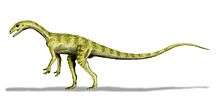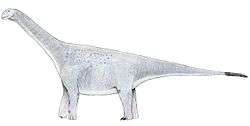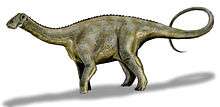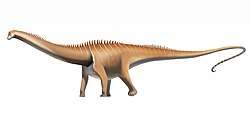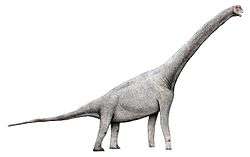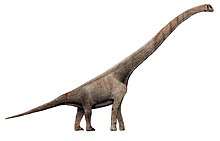Lirainosaurus
Lirainosaurus (meaning "slender lizard"; from the Basque lirain, meaning "slender", and the Greek sauros, meaning "lizard"[1])is a genus of titanosaur sauropod which lived in what is now Spain. The type species, Lirainosaurus astibiae, was described by Sanz, Powell, Le Loeuff, Martinez, and Pereda-Suberbiola in 1999.[2]
| Lirainosaurus | |
|---|---|
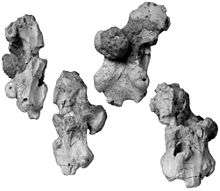 | |
| Paratype braincase | |
| Scientific classification | |
| Kingdom: | Animalia |
| Phylum: | Chordata |
| Clade: | Dinosauria |
| Clade: | Saurischia |
| Suborder: | †Sauropodomorpha |
| Clade: | †Sauropoda |
| Clade: | †Titanosauria |
| Clade: | †Lithostrotia |
| Genus: | †Lirainosaurus Sanz et al., 1999 |
| Species: | †L. astibiae |
| Binomial name | |
| †Lirainosaurus astibiae Sanz et al., 1999 | |
Systematics
This genus was based on a skull fragment, isolated teeth, several vertebrae including the holotype - an anterior caudal vertebra, and appendicular bones from the Late Cretaceous of Laño (northern Spain). New material from Laño, Spain described by Diaz et al. (2013), which includes cervical, dorsal and caudal vertebrae, dorsal ribs, and a haemal arch, has been assigned to Lirainosaurus.[3] According to Diaz et al., Lirainosaurus can be distinguished by the presence of a lamina in the interzygapophyseal fossa of the most proximal caudal vertebrae; and the spinopostzygapophyseal structure not posteriorly projected in the posterior caudal vertebrae. With respect to phylogeny, the combination of characters present in the new axial remains described, supports the placement of Lirainosaurus as a derived lithostrotian titanosaur closely related to the Saltasaurinae. The results of an unpublished SVPCA abstract published in 2016 narrow down the exact position of Lirainosaurus by placing it as closer to Alamosaurus and Opisthocoelicauda than to Saltasaurus.[4] Later, Diez Diaz et al. (2018) erected Lirainosaurinae to accommodate Lirainosaurus as well as Ampelosaurus and Atsinganosaurus.[5]
Paleoecology
Specimens have been found in the North-Pyrenean site of Bellevue, which is located at the base of the Marnes de la Maurine member of the Marnes Rouges Inférieures Formation. Marine biostratagraphic testing of the formation places its age somewhere between Late Campanian to Early Maastrichtian. Other contemporary dinosaurs in the Bellevue layer include the titanosaur sauropod Ampelosaurus, the rhabdodontid Rhabdodon and indeterminate ankylosaur and Dromaeosauridae elements.[6]
Other material ascribed to Lirainosaurus have been found in the Fox-Amphoux–Métisson locality, where unfortunately no magnetostratigraphic dating has been performed. However, the local stratigraphy presents the same succession of facies as in the Aix-en-Provence Basin, which is also in the Late Campanian to Early Maastrichtian age.
References
- http://www.paleofile.com/Miscellaneous/Intigument/SkinScales/Lirainosaurus.asp
- J. L. Sanz, J. E. Powell, J. Le Loeuff, R. Martinez, and X. Pereda-Suberbiola (1999). "Sauropod remains from the Upper Cretaceous of Laño (north central Spain). Titanosaur phylogenetic relationships." Estudios del Museo de Ciencias Naturales de Alava 14(1):235-255
- Díez Díaz, V., Pereda Suberbiola, X. and Sanz, J.L. 2013. The axial skeleton of the titanosaur Lirainosaurus astibiae (Dinosauria: Sauropoda) from the latest Cretaceous of Spain. Cretaceous Research, 43:145-160.
- "Archived copy" (PDF). Archived from the original (PDF) on 2016-09-15. Retrieved 2016-08-24.CS1 maint: archived copy as title (link)
- Verónica Díez Díaz; Géraldine Garcia; Xabier Pereda Suberbiola; Benjamin Jentgen-Ceschino; Koen Stein; Pascal Godefroit; Xavier Valentin (2018). The titanosaurian dinosaur Atsinganosaurus velauciensis (Sauropoda) from the Upper Cretaceous of southern France: New material, phylogenetic affinities, and palaeobiogeographical implications. Cretaceous Research. in press. doi:10.1016/j.cretres.2018.06.015.
- B. Vila; A. Galobart; J.U. Canudo; J. Le Loeff; et al. (2012). "The diversity of sauropod dinosaurs and their first taxonomic succession from the latest Cretaceous of southwestern Europe: Clues to demise and extinction". Palaeogeography, Palaeoclimatology, Palaeoecology. 350-352 (15): 19–38. doi:10.1016/j.palaeo.2012.06.008.
